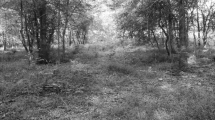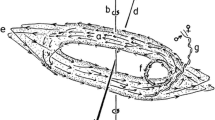Abstract
North European Leptoceridae (Trichoptera) perform three types of swarming flight patterns: (1) swarming males of Athripsodesand Ceracleafly in horizontal zigzag patterns over the water surface, (2) the Mystacidesspp. perform vertical zigzag movements, and (3) the flight of males of Triaenodes unanimisMcLach. is a mixture of the horizontal and vertical zigzagging. Also three groups of pair formation behavior can be distinguished. In the first group, of Athripsodesand Ceraclea,the females fly into the male swarms, where they are grasped and carried to the riparian vegetation by the flying males with the females hanging upside-down in genitalia coupling. In the second group, a Mystacidesfemale is caught by a male, when approaching a swarm and both use their wings to fly in tandem to the shore where they copulate. In the third group, of Triaenodes bicolor(Curt.) and Oecetis lacustris(Curt.), the males fly searching for females sitting on aquatic plants and when a female is found the male lands and they copulate immediately while clinging to the plant. The different swarming and mating behaviors might have favored selection for three types of sexual dimorphism: (1) longer forewings in males than females in species which fly in copula, (2) larger eyes in males of the vertically zigzagging species, and (3) much smaller males in the group where males search for females sitting on aquatic plants. In the second group approaching females are detected by males before reaching the swarm and in the third group the female almost always mates with the male which is the first to find her. In conclusion, we suggest that females of Athripsodesand Ceracleahave a greater choice among swarming males than do females of Mystacides, T. bicolor,and O. Lacustris.
Similar content being viewed by others
References
Andersen, T., and Wiberg-Larsen, P. (1987). Revised check-list of NW European Trichoptera.Ent. Scand. 18: 165–184.
Ansteeg, O., and Dettner, K. (1991). Chemistry and possible biological significance of secretions from a gland discharging at the 5th abdominal sternit of adult caddisflies (Trichoptera).Ento-mol. Gener. 15(4): 303–312.
Becker, G. (1987). Lebenszyklus, Reproduktion und ökophysiologische Anpassungen vonHydropsyche contubernalis, einer Köcherfliege mit Massenvorkommen im Rhein. Inaugural-Dissertation zur Erlangung des Doktorsgrades der Mathematisch-Naturwissenschaftlichen Fakultät der Universität zu Köln.
Benz, G. (1975). Über die Tanzschwärme der KöcherfliegeHydropsyche pellucidula Curtis (Tri-choptera: Hydropsychidae).Mitt. Schweiz. Entomol. Ges. 48: 147–157.
Betten, C. (1934). The caddisflies or Trichoptera of New York State.N. Y State Mus. Bull. 292: 1–576.
Bradbury, J. W. (1985). Contrasts between insects and vertebrates in the evolution of male display, female choice, and lek mating. In Hölldobler, B., and Lindauer, M. (eds.),Experimental Behavioral Ecology, Fischer, Stuttgart, pp. 273–289.
Crichton, M. I. (1965). Observations on captures of Trichoptera in suction and light traps near Reading, Berkshire.Proc. R. Ent. Soc. Lond. A 40: 101–108.
Dahl, C. (1965). Studies on swarming activity in Trichoceridae (Diptera) in Southern Sweden.Opusc. Entomol. Suppl. 27: 1–68.
Dillon, W. R., and Goldstein, M. (1984).Multivariate Analysis, Methods and Applications, John Wiley & Sons, New York.
Downes, J. A. (1969). The swarming and mating flight of Diptera.Annu. Rev. Entomol. 14: 271–298.
Gruhl, K. (1960). Die Tanzgesellschaft derHydropsyche saxonicaMcLach. (Trichoptera).Mitt. dtsch. Entomol. Ges. 19: 76–83.
Harvey, P. H., and Clutton-Brock, T. H. (1985). Life history variation in primates.Evolution 39: 599–581.
Harvey, P. H., and Harcourt, A. H. (1984). Sperm competition, testis size, and breeding systems in primates. In Smith, R. L. (ed.),Sperm Competition and the Evolution of Animal Mating Systems, Academic Press, New York, pp. 589–599.
Ivanov, V. D. (1985a). Behaviour of caddis flies in their flight.Latvijas Entomol. Riga 28: 85–94 (in Russian with an English summary).
Ivanov, V. D. (1985b). A comparative analysis of wing kinematics in caddis flies (Trichoptera).Rev. Entomol. USSR. 64: 273–284 (in Russian with an English abstract).
Kelner-Pillault, S. (1975). Attirance sexuelle chez un Trichoptère:Enoicyla pusilla Burmeister.Bull. Soc. Entomol. Fr. 80: 252–257.
Lande, R. (1987). Genetic correlates between the sexes in the evolution of sexual dimorphism and mating preferences. In Bradbury, J. W., and Andersson, M. B. (eds.),Sexual Selection: Testing the Alternatives, John Wiley & Sons, New York, pp. 55–66.
Löfstedt, C., Hansson, B. S., Petersson, E., Valeur, P., and Richards, A. Pheromonal secretions from glands on the 5th abdominal sternite of caddisflies (Trichoptera) belonging to the Hydro-psychidae and Rhyacophilidae families. Unpublished manuscript.
Malicky, H. (1978). The taxonomic significance of eye proportions in adult caddis flies. In Crichton, M. I. (ed.), Proc. 2nd Int. Symp. Trichoptera, (Junk), The Hague, pp. 156–157.
Manuel, K. L., and Nimmo, A. P. (1984). The caddis fly genusYlodes in North America (Tri-choptera: Leptoceridae). In Morse, J. C. (ed.),Proc. 4th Int. Symp. Trichoptera, Junk, The Hague, pp. 219–224.
McLachlan, R. (1877).A Monographic Revision and Synopsis of the Trichoptera of the European Fauna, 1874–1880, reprinted 1968, E. W. Classey, Hampton.
Mori, S., and Matutani, K. (1953). Daily swarmings of some caddis fly adults and their habitat segregations.Zool. Mag. (Tokyo) 62: 191–198 (in Japanese with an English abstract).
Petersson, E. (1989).Mating in the Swarming Caddis Flies (Trichoptera: Leptoceridae), Ph.D. thesis, University of Uppsala, Sweden.
Petersson, E., and Solem, J. O. (1987). Male mate recognition in Leptoceridae. In Bournaud, M., and Tachet, H. (eds.),Proc. 5th. Int. Symp. Trichoptera, Junk, The Hague, pp. 157–160.
Rao, C. R. (1973).Linear Statistical Inference and Its Applications, John Wiley and Sons, New York.
Resh, V. H., and Wood, J. R. (1985). Site of sex pheromone production in three species of Trichoptera.Aquat. Insects 7: 65–71.
Resh, V. H., Jackson, J. K., and Wood, J. C. (1987). Techniques for demonstrating sex pheromones in Trichoptera. In Bournaud, M., and Tachet, H. (eds.),Proc. 5th. Int. Symp. Trichoptera, Junk, The Hague, pp. 161–164.
Ris, F. (1904a). Ein unbekanntes Organ der PhryganidenOecetis notata undOecetis testacea.Vierteljahrsschr. Naturf. Gesell. Zürich 49: 370–375.
Ris, F. (1904b). Über ein unbekanntes Organ der PhryganidenOecetis notata undOecetis testacea.Mitt. Schweiz. Ent. Ges. Schaffhausen 11: 63–65.
Schuhmacher, H. (1969). Das Schwärmverhalten vonHydropsyche borealis Martynov (Insecta, Trichoptera).Zool. Anz. (Suppl.) BD Verh. Zool. Ges. 33: 555–558.
Silfvenius, A. J. (1906). Trichopterologische Untersuchungen I. Über den Laich der Trichopteren.Acta Soc. Fauna Flora Fenn. 28(4): 1–128.
Solem, J. O. (1978). Swarming and habitat segregation in the family Leptoceridae (Trichoptera).Norw. J. Entomol. 25: 145–148.
Solem, J. O. (1984). Adult behaviour of north European caddis flies. In Morse, J. C. (ed.),Proc. 4th Int. Symp. Trichoptera, Junk, The Hague, pp. 375–382.
Solem, J. O., and Petersson, E. (1987). Demonstration of sex pheromones and adult behaviour inMolanna angustata Curtis (Molannidae, Trichoptera).Entomol. General. 12(2/3): 115–118.
Statzner, B. (1978). The effects of flight behaviour on the larval abundance of Trichoptera in the Schierenseebrooks (North Germany). In Crichton, M.I. (ed.),Proc. 2nd Int. Symp. Trichop-tera, Junk, The Hague, pp. 121–134.
Svärd, L. (1988).Mating Strategies of Male Butterflies in Relation to Female Fecundity and Polyan-dry, Doctoral thesis, Stockholm University, Stockholm, Sweden.
Thornhill, R., and Alcock, J. (1983).The Evolution of Insect Mating Systems, Harvard University Press, Cambridge, MA.
Weaver, J. S., III, and Morse, J. C. (1986). Evolution of feeding and case-making behavior in Trichoptera.J. N. Am. Benthol. Soc. 5: 150–158.
Wesenberg-Lund, C. (1913). Fortpflanzungverhältnisse: Paarung und Eiblage der Süsswasserinsek-ten.Fortschr. Naturw. Forsch. 8: 161–286.
Wesenberg-Lund, C. (1943).Biologie der Süsswasserinsekten, Gyldendal, Copenhagen.
Wood, J. R., and Resh, V. H. (1984). Demonstration of sex pheromones in caddisflies (Trichoptera).J. Chem. Ecol. 10: 171–175.
Author information
Authors and Affiliations
Rights and permissions
About this article
Cite this article
Gullefors, B., Petersson, E. Sexual dimorphism in relation to swarming and pair formation patterns in leptocerid caddisflies (Trichoptera: Leptoceridae). J Insect Behav 6, 563–577 (1993). https://doi.org/10.1007/BF01048123
Accepted:
Issue Date:
DOI: https://doi.org/10.1007/BF01048123




